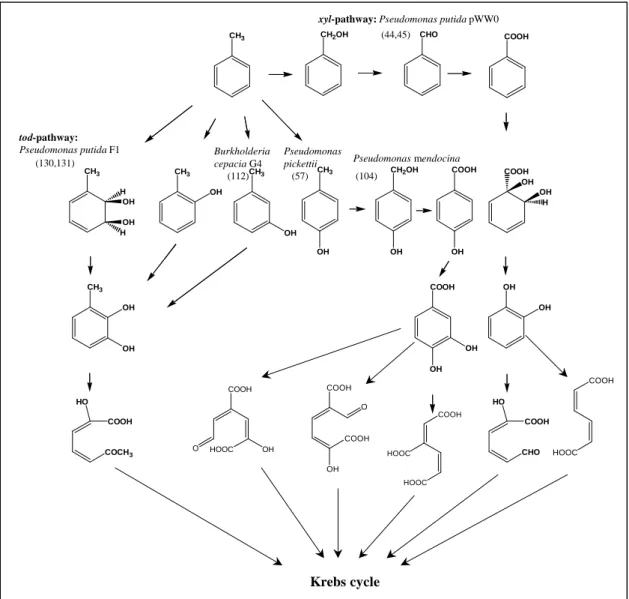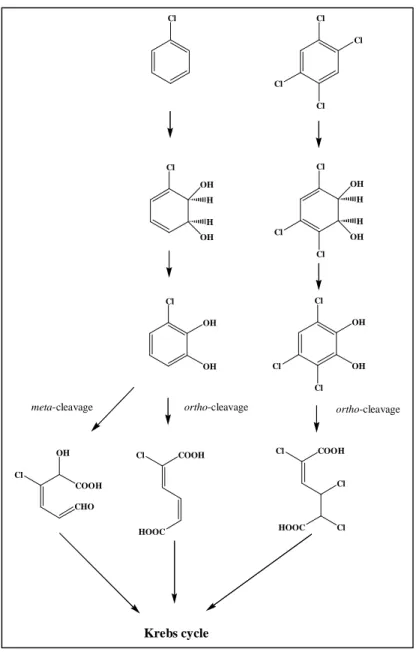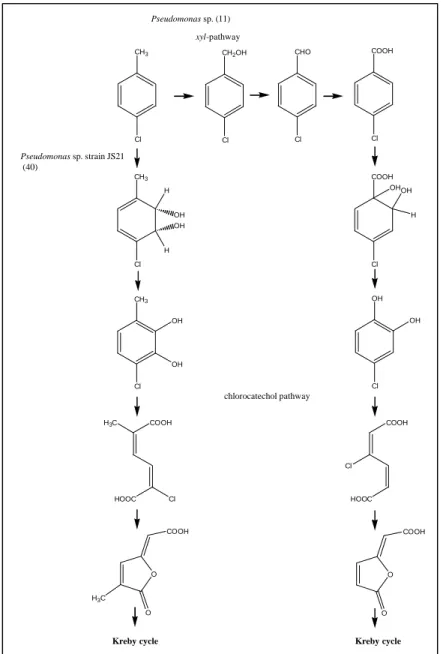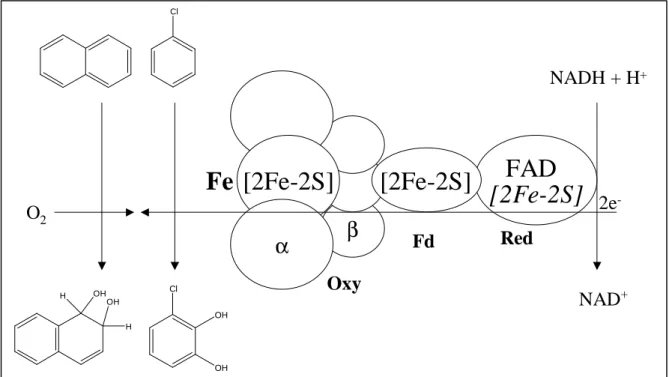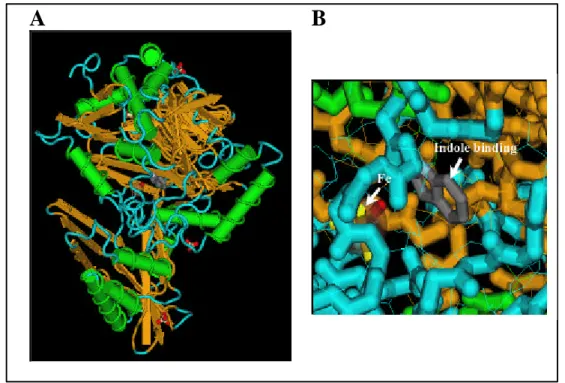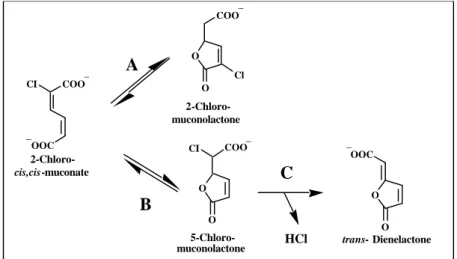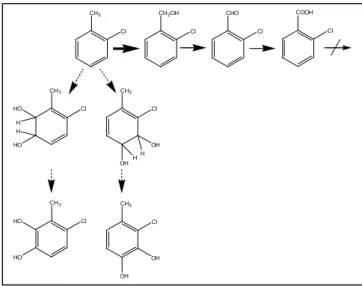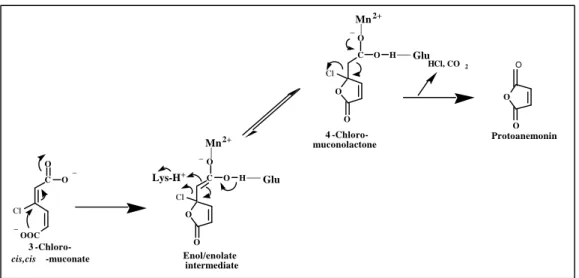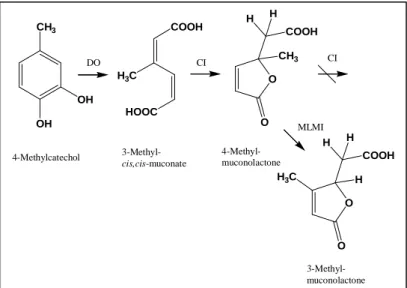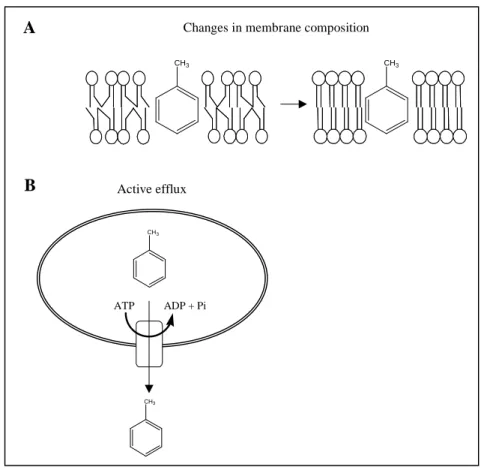Abbau von Chlorbenzolen und Chlortoluolen durch natürliche und konstruierte Mikroorganismen
Der Gemeinsamen Naturwissenschaftlichen Fakultät der Technischen Universität Carolo-Wilhelmina
zu Braunschweig zur Erlangung des Grades einer Doktorin der Naturwissenschaften
(Dr. rer. nat.) genehmigte D i s s e r t a t i o n
KUMULATIVE ARBEIT
von:... Katrin Pollmann aus:... Münster/Westf.
1. Referent:... PD Dr. Dietmar H. Pieper 2. Referent:... Prof. Dr. K. N. Timmis Eingereicht am:... 23.09.2002
Mündliche Prüfung (Disputation) am: ... 20.12.2002
Vorveröffentlichungen der Dissertation
Teilergebnisse aus dieser Arbeit wurden mit Genehmigung der Gemeinsamen
Naturwissenschaftlichen Fakultät, vertreten durch den Mentor der Arbeit, in folgenden Beiträgen vorab veröffentlicht:
Publikationen:
Pollmann, K., Beil, S., Pieper, D. H.: Transformation of chlorinated benzenes and toluenes by Ralstonia sp. strain PS12 tecA (tetrachlorobenzene dioxygenase) and tecB (chlorobenzene dihydrodiol dehydrogenase) gene products. Appl. Environ. Microbiol.
67:4057-4063. (2001)
Pollmann, K., S. R. Kaschabek, V. Wray, W. Reineke, and D. H. Pieper. Metabolism of dichloromethylcatechols as central intermediates in the degradation of dichlorotoluenes by Ralstonia eutropha sp. strain PS12. J. Bacteriol. (2002) (In Druck).
Katrin Pollmann, Victor Wray, Hans-Jürgen Hecht and Dietmar H. Pieper. Directed engineering of the regioselectivity of TecA tetrachlorobenzene dioxygenase for the transformation of chlorinated toluenes. Eingereicht zur Publikation bei J. Bacteriol.
Tagungsbeiträge:
Pollmann, K., Pieper, D. H.: Degradation of 2,5-dichlorotoluene by Ralstonia sp. strain PS12 (Poster). Biotechnology for environmental applications. Roskilde, Dänemark (2000).
Pollmann, K., Pieper, D. H.: In situ 1H NMR analysis: A useful tool for analyzing the degradation pathway of dichlorotoluenes (Poster). First European Bioremediation Conference. Chania, Griechenland (2001).
TABLE OF CONTENTS
LISTE DER VORABVERÖFFENTLICHUNGEN
CHAPTER I:
1. GENERAL INTRODUCTION...5
1.1. Chloroaromatics in the environment...6
1.2. Aerobic bacterial metabolism of aromatic compounds...7
1.2.1. Toluene...7
1.2.2. Chlorinated benzenes... 9
1.2.3. Chlorinated toluenes...10
1.3. Aromatic ring-hydroxylating dioxygenases... 13
1.4. Bacterial ring-hydroxylating dioxygenases...16
1.5. Muconate and chloromuconate cycloisomerases...16
1.6. Problems in degradation of chloroaromatics...19
1.6.1. Misrouting of substrates into dead end pathways...19
1.6.2. Formation of dead end products by cycloisomerization of substituted muconates19 1.6.3. Toxicity of solvents...22
1.7. The strain Ralstonia sp. PS12...22
1.8. The strain Pseudomonas putida DOT-T1E...23
1.9. Engineering of bacteria for environmental applications...23
1.9.1. Genetic engineering by patchwork assembly...23
1.9.2. Protein engineering...24
1.9.3. DNA shuffling and random mutagenesis...24
1.10. Aim of the thesis...25
1.11. References...27
CHAPTER II:
TRANSFORMATION OF CHLORINATED BENZENES AND TOLUENES BY TECA TETRACHLOROBENZENE DIOXYGENASE AND TECB CHLOROBENZENE
DIHYDRODIOL DEHYDROGENASE OF RALSTONIA SP. STRAIN PS12 ...36
2.1 Abstract...37
2.2 Introduction...37
2.3. Materials and methods...39
2.4 Results...41
2.5 Discussion...48
2.6 References...52
CHAPTER III: METABOLISM OF DICHLOROMETHYLCATECHOLS AS CENTRAL INTERMEDIATES IN THE DEGRADATION OF DICHLOROTOLUENES BY RALSTONIA EUTROPHA SP. STRAIN PS12...55
3.1 Abstract...56
3.2 Introduction...57
3.3 Materials and methods...60
3.4 Results...66
3.5 Discussion...81
3.6 Acknowledgments...89
3.7 References...89
CHAPTER IV:
DIRECTED ENGINEERING OF THE REGIOSELECTIVITY OF TECA
TETRACHLOROBENZENE DIOXYGENASE FOR THE TRANSFORMATION OF
CHLORINATED TOLUENES...94
4.1 Abstract...95
4.2 Introduction...96
4.3 Materials and methods...98
4.4 Results...102
4.5 Discussion...109
4.6 References...114
CHAPTER V: CHLOROMETHYLMUCONOLACTONES AS CRITICAL METABOLITES IN THE DEGRADATION OF CHLOROMETHYLCATECHOLS: WHY 2-CHLOROTOLUENE IS SO DIFFICULT TO DEGRADE...117
5.1 Abstract...118
5.2 References...128
CHAPTER VI:
CONSTRUCTION OF A SOLVENT TOLERANT PSEUDOMONAS PUTIDA STRAIN ABLE TO DEGRADE HIGH CONCENTRATIONS OF
CHLOROBENZENE...131
6.1 Abstract...132
6.2 Introduction...132
6.3 Materials and methods...135
6.4 Results...140
6.5 Discussion...148
6.6 References...152
CHAPTER VII: GENERAL DISCUSSION...157
7.1 Degradation of chlorinated toluenes...159
7.2 Artificial evolution of enzymes and pathways to create new biocatalysts...161
7.3 Construction of a solvent tolerant chlorobenzene degrading strain...162
7.4 Outlook...163
7.5 References...165
LEBENSLAUF
DANKSAGUNGEN
Chapter I
GENERAL
INTRODUCTION
1.1 Chloroaromatics in the environment
During the last decades, the production of aromatic compounds and haloaromatics increased significantly due to their widespread use as solvents and for the synthesis of many substances such as dyes and pesticides. This extensive use of chloroaromatics by the chemical industry (e.g..
production of 60,000 t chlorotoluenes in 2000 by Bayer (112)) has led to their widespread release into the environment through volatilization, leakage and disposal of industrial wastes (88) (e.g. about 1 t of chlorotoluenes in 1988/89 in West Germany (23)). A prominent example is the industrial waste site near Bitterfeld where significantly increased atmospheric concentrations of chlorobenzenes were detected (97). Since industrial synthesized chloroaromatics are usually not found in nature in such high concentrations, they are often poorly degradable and persist in nature (1). However, a wide variety of naturally occurring organohalogenes has been identified, which may have contributed to the adaptation of microorganisms to xenobiotics and to the evolution of degradation pathways (3).
Chlorotoluenes are produced by chlorination of toluenes. They are widely used by the chemical industry as solvents and intermediates in the synthesis of organic chemicals, dyes, pharmaceuticals and synthetic rubber chemicals and are still produced in high amounts (23, 34, 35). 4-Chlorotoluene is used as a starting material in the synthesis of 2,4- and 3,4- dichlorotoluene and of 4-chlorobenzonitril (35). 2-Chlorotoluene is a starting material in the production of 2-chlorobenzyl chloride, 2-chlorobenzaldehyde, 2-chlorobenzotrichloride, and 2- chlorobenzoic acid, which are in turn precursors for dyes, pharmaceuticals, optical brighteners and fungicides. 2-Chlorotoluene is also used in the production of dichlorotoluenes and o- chlorobenzonitrile (35). Dichlorotoluenes are used as intermediates in the manufacture of fungicides, herbicides, dyes, pharmaceuticals, preservatives, and peroxides (35). Exposure to these compounds cause headache, irritation of the skin, sickness, but also unconsciousness and shortness of breath (23).
Chlorinated benzenes form another group of pollutants, which are used as a solvents in pesticide formulations, as solvents for paints and other industrial applications, for degreasing, in the manufacturing of phenol, aniline and for the production of dyes, crop protection agents, pharmaceuticals, rubber chemicals etc. (1, 15, 35). Among others, chlorobenzene has been identified as priority pollutant by the U.S. Environmental protection Agency (53).
1.2 Aerobic bacterial metabolism of aromatic compounds
Despite the toxicity of aromatic compounds a large number of microorganisms have been isolated from environment that are capable of degrading and mineralizing these compounds and aerobic as well as anaerobic degradation pathways have been described. In case of aerobic degradation of aromatic compounds, the substrates are generally channeled via a few central metabolites into common pathways (47, 131). In the first stage, the aromatic ring is activated by introduction of two hydroxyl groups catalyzed by specialized mono- or dioxygenases. In the second stage, the resulting dihydroxylated aromatics undergo either intra- or extradiol ring cleavage, catalyzed by intra- or extradiol dioxygenases, respectively. The aliphatic acids formed are metabolized to Krebs cycle intermediates, which are used for biosynthesis or energy production.
1.2.1 Toluene
The capability to mineralize toluene is obviously widespread in bacteria. For aerobic degradation, five different metabolic routes have been described (Fig. 1). The TOL plasmid pWW0 of Pseudomonas putida, encoding enzymes of the tol-pathway, is the most extensively characterized catabolic plasmid (45, 46). In this tol-pathway, the methylgroup of toluene is sequentially oxidized to yield benzoate (upper pathway). The carboxylic acid is then oxidized to catechol by the action of toluate dioxygenase and 1,2-dihydroxycyclo-3,5-hexadiene-1- carboxylate dehydrogenase.
In the tod-pathway, extensively investigated for Pseudomonas putida F1 (132, 133), the aromatic ring is activated by the introduction of two hydroxyl groups, catalyzed by toluene 2,3- dioxygenase. The dioxygenation is followed by rearomatization of cis-toluene-2,3-dihydrodiol by a dehydrogenase to give 3-methylcatechol.
Furthermore, three different types of monooxygenases – toluene-2-, toluene-3- and toluene-4- monooxygenase - have been described, catalyzing the hydroxylation of the aromatic ring of toluene to ortho-, meta- and para-cresol, respectively (58, 106, 114). In case of o- and m-cresol, the phenolic intermediates are converted to 3-methylcatechol, whereas p-cresol is transformed to protocatechuate with p-hydroxybenzylalcohol, p-hydroxybenzaldehyde and p-hydroxybenzoate as intermediates (106) (Fig. 1).
FIG. 1: Bacterial pathways for the degradation of toluene: ortho- and meta-cleavage pathways (45, 46, 58, 106, 114, 132, 133).
(130, 131)
(112) (57) (104)
(44,45)
xyl-pathway:Pseudomonas putidapWW0
tod-pathway:
Pseudomonas putidaF1
Pseudomonasmendocina Pseudomonas
pickettii Burkholderia cepaciaG4
HOOC COOH
O OH
COOH COOH
OH O
COOH
HOOC HOOC
COOH
HOOC
Krebs cycle
CH3
CH3 H
H OH OH
OH
OH CH3
CH2OH CHO
COOH OH
OH H
OH OH
COCH3 COOH HO
COOH
CHO HO
CH3 CH3 CH3
OH
OH OH
CH2OH
COOH
OH
COOH
OH
COOH
OH OH (44,45)
(130,131)
(112) (57) (104)
Methylcatechols, formed as central intermediates in dioxygenolytic as well as in o- and m-cresol pathways, usually undergo meta-fission to produce hydroxymuconic semialdehydes, which are further transformed into Krebs-cycle products (Fig. 1). Catechol undergoes either intradiol cleavage resulting in the formation of muconate, which is channeled into the Krebs cycle in subsequent reactions or is metabolized via a meta-cleavage pathway. Protocatechuate, the product of p-cresol transformation, like catechol, can be subject to ortho- (3,4-) or to meta- (2,3- or 4,5-) ring-cleavage with the resulting products being channeled into the Krebs cycle.
1.2.2 Chlorinated benzenes
In contrast to toluene degrading organisms, organisms capable to mineralize chlorobenzenes, have been relatively seldom described. Mineralization of chlorobenzene, first described by Reineke and Knackmuss (105), is initialized by a dioxygenolytic attack on the aromatic ring analogues to the toluene 2,3-dioxygenase catalyzed dioxygenation of toluene (Fig 2).
Subsequently the resulting cis-dihydrodiol is converted by a dehydrogenase to give 3- chlorocatechol, regaining the aromatic structure. Analogously, degradation of higher chlorinated benzenes such as 1,2-, 1,3-, 1,4-dichloro- and 1,2,4-trichlorobenzene is initialized by dioxygenation followed by dehydrogenation yielding the corresponding chlorocatechols as central intermediates. In case of 1,2,4,5-tetrachlorobenzene, the mineralization of which was described thus far only by two bacterial strains, dioxygenation is accompanied by chloride elimination to give 3,4,6-trichlorocatechol, as described for the strain Ralstonia sp. PS12 (7) (Fig. 2).
The majority of bacteria capable of mineralizing chlorinated benzenes metabolize the resulting chlorocatechols by enzymes of the modified ortho-pathway via the corresponding muconates and dienelactones as intermediates. Elimination of a chloride occurs after intradiol ring cleavage. In contrast, meta-cleavage of chlorocatechols usually leads to substrate misrouting or formation of a suicide product. Nevertheless, in the strain Pseudomonas putida GJ31 the degradation of 3- chlorocatechol via meta-cleavage pathway has been described (76). This strain contains a chlorocatechol 2,3-dioxygenase that can efficiently cleave 3-chlorocatechol at the 2,3-position along with simultaneous dechlorination producing 2-hydroxy-cis,cis-muconate (59, 76).
FIG. 2: Degradation of chlorobenzene via ortho- and meta-cleavage (59, 76, 105) and of 1,2,4,5-tetrachlorobenzene via ortho-cleavage (7).
1.2.3 Chlorinated toluenes
Degradation of aromatic compounds carrying both methyl- and chlorosubstituents was assumed to be difficult. Whereas methylcatechols formed from toluene or xylenes are usually mineralized by a meta-cleavage (extradiol) pathway, intradiol cleavage often results in accumulation of methylsubstituted muconolactones as dead end metabolites (18, 70) and only specialized pathways are capable to further metabolize those lactones (13, 89). On the other hand, chlorosubstituted catechols are usually metabolized via an ortho-cleavage pathway (103), which
Cl Cl
Cl
Cl Cl
Cl OH
OH H
H H
H Cl
Cl Cl
OH
OH
Cl OH
OH
Cl OH
OH Cl Cl
COOH
CHO COOH OH Cl
HOOC
Cl COOH
HOOC Cl
Cl Cl
Krebs cycle
meta-cleavage ortho-cleavage ortho-cleavage
involves intradiol cleavage by a chlorocatechol 1,2-dioxygenase. Even though chlorocatechols can be channeled into some meta-cleavage routes, extradiol cleavage usually results in the formation of dead end metabolites or suicide products, e. g. the highly reactive 5-chloroformyl- 2-hydroxy-penta-2,4-dionic acid that is assumed to be the product of a distal (1,6-) cleavage of 3-chlorocatechol, which inactivates the catechol 2,3-dioxygenase (4). Additionally, accumulated chlorocatechols can inhibit catechol 2,3-dioxygenases (68). Thus, the simultaneous degradation of methyl- and chloroaromatics was observed to be problematic (99, 25).
However, even though mixtures of methyl- and chlorosubstituted aromatics were observed to be difficult to degrade, mixed substituted chloromethylsubstituted aromatics not necessarily should create problems in degradation via ortho-cleavage routes. As long as a chloride substituent can be eliminated during cycloisomerisation, the formation of methylsubstituted muconolactones will be prevented in favor of the formation of methylsubstituted dienelactones. Several strains have been described to utilize chloro-, and dichlorotoluenes and natural and constructed bacterial strains capable to mineralize 3- or 4-chlorotoluene have been analyzed in detail (11, 40, 109, 123). For metabolism of 4-chlorotoluene, two metabolic routes have been reported. A mutant of strain Pseudomonas JS6 has been described to metabolize 4-chlorotoluene analogous to chlorobenzene via a modified ortho-pathway (40) with 3-chloro-6-methylcatechol as intermediate (Fig. 3). Thus, this mixed substituted catechol seem to create no metabolic problem for the strain. Another route of chlorotoluene degradation has been described by Brinkmann et al. (11). A strain capable of degrading 3-, 4-chlorotoluene and 3,5-dichlorotoluene was constructed by combining the TOL plasmid from Pseudomonas putida strain PaW1, encoding xylene monooxygenase, benzylalcohol dehydrogenase, benzaldehyde dehydrogenase, toluate dioxygenase and toluate dihydrodiol dehydrogenase, with genes encoding the chlorocatechol pathway enzymes of strain Pseudomonas putida B13 (11). Thereby, a derivative strain was obtained capable of transforming 3-, 4-chloro-, and 3,5-dichlorotoluene into 3-chloro-, 4-chloro-, and 3,5-dichlorocatechol via the corresponding benzylalcohols, benzaldehydes and benzoates by the action of enzymes of the tol-pathway and mineralizing the respective catechols by the enzymes of the chlorocatechol pathway (Fig. 3). However, 2-chlorosubstituted toluenes cannot be channelled into such a pathway due to the restricted substrate specificity of xylene monooxygenase.
Only restricted knowledge is available on the degradation of dichlorotoluenes. Vandenbergh (123) described a Pseudomonad able to use several chloroaromatics such as 2,4- and 3,4- dichlorotoluene as growth substrates but no pathways were given. The strain Ralstonia PS12
able to grow on 1,2,4,5-tetrachlorobenzene was described to utilize various dichlorotoluenes as well (109), but no metabolic pathway has been described so far.
FIG. 3: Degradation of 4-chlorotoluene by Pseudomonas sp. strain JS21, a derivative of the strain JS6 (40) and a constructed hybrid strain of Pseudomonas sp., resulting from the mating of the strains B13 and PaW1 (11).
CH3
Cl
CH3
Cl H
OH
H OH
CH3
Cl OH
OH
COOH
HOOC H3C
Cl
O
O COOH
H3C
CH2OH
Cl
CHO
Cl
COOH
Cl
COOH
Cl OHOH
H
OH
Cl OH
COOH
HOOC Cl
O
O COOH Pseudomonassp. strain JS21
(40)
Pseudomonassp. (11) xyl-pathway
chlorocatechol pathway
Kreby cycle Kreby cycle
1.3 Aromatic ring-hydroxylating dioxygenases
The initial reaction in bacterial aerobic metabolism of many aromatic compounds is catalyzed by multicomponent aromatic ring hydroxylating dioxygenase systems, which add both atoms of dioxygen to the aromatic ring to produce cis-dihydrodiols (77). These oxygenases are multi enzyme complexes consisting of three or four proteins. However, since the aromatic hyrocarbon dioxygenase family also comprises monooxygenases and enzymes that do not hydroxylate aromatic rings, Gibson and Parales (32) suggested changing the family name to Rieske non- heme iron oxygenases.
As an example, the recently crystallized and extensively studied naphthalene dioxygenase (NDO) from Pseudomonas sp. strain NCIB 9816-4 (17, 25, 26, 38, 39, 72), that catalyzes the conversion of naphthalene into cis-naphthalene dihydrodiol, consists of three functional components that are composed of four proteins (Fig. 4).
Members of the Rieske non-heme iron oxygenases had been classified into three groups as Class I, II and III depending on their structure and the nature of redox centers (5). Recent studies have shown that the oxygenase a-subunits determine the substrate specificities of various dioxygenases, including naphthalene, biphenyl, chlorobenzene and nitrotoluene dioxygenases (8, 28, 33, 84, 85). As discussed by Gibson and Parales the former classification scheme, which does not take into account any information on the oxygenases itself, seems therefore not to be useful anymore (37). As all Rieske non-heme iron oxygenases are related to each other, dioxygenase families can be identified based on amino acid sequences of the catalytic oxygenase α−subunits (129) and four families (naphthalene, toluene/biphenyl, benzoate and phthalate oxygenases) have recently been proposed (37). In general, the thus identified clustering of oxygenases into families correlates with the native substrate oxidized by the members.
FIG. 4: Typical biochemical organization of the toluene/benzene and napthalene dioxygenase system (5). Red: reductase component; Oxy: oxygenase component; Fd: ferredoxin; the electrons are transferred from NADH + H+ via the reductase containing FAD as prosthetic group (Benzene dioxygenase) and a plant type Rieske center (only Naphthalene dioxygenase, italic letters) and ferredoxin to a terminal oxygenase component consisting of a-and ß-subunits; both atoms of molecular dioxygen are incorporated into the aromatic compound at the active site iron (Fe2+) resulting in a cis-dihydrodiol.
In naphthalene dioxygenase, electrons are transferred from NAD(P)H through an iron sulfur flavoprotein reductase and a Rieske iron-sulfur ferredoxin [2Fe-2S] to the terminal catalytic oxygenase component (25, 26, 38, 39). The oxygenase consists of large a- and small ß- subunits in a3ß3-configuration (61). Each a-subunit contains a Rieske [2Fe-2S] center and a mononuclear nonheme iron. The electrons are transferred from the Rieske center in one a-subunit to the mononuclear iron located in the adjacent a-subunit, that is the site of activation and catalysis (61, 86). Crystallization and determination of the three-dimensional structure of NDO (Fig. 5) and docking studies with indole, naphthalene and biphenyl suggested the location of substrate and dioxygen binding and the underlying mechanism of catalysis (17). The substrate pocket is a flattened and elongated cavity. With the exception of the mononuclear iron and a polar region located at the bottom, the walls of the active site cavity are mainly hydrophobic, allowing the accommodation of hydrophobic substrates such as naphthalene and indole (Fig. 5). The crystal structure allowed the identification of amino acids near the active site iron such as Asp205, Asn201, and Phe352 (17). The substrate is orientated making a favorable bond to the carbonyl
β
[2Fe-2S] FAD [2Fe-2S]
α
NADH + H+
NAD+ 2e-
Cl
Cl OH
OH
O2
Red Oxy
Fd
[2Fe-2S]
H OH
H OH
Fe
oxygen atom of Asp205 and close to the carbonyl oxygen of Asn201, such that the distance between the substrate and the iron at the active site is suitable for a dioxygen bridge (17). Recent studies have identified the amino acid Phe352 to determine regioselectivity and enantioselectivity of NDO (85, 87).
FIG. 5: Structure of naphthalene 1,2-dioxygenase (NDO) with indole bound (17) (Pdb Id:
1EG9). A: Secondary structure of the a-subunit; only protein backbones with helices (tubes) and sheets are drawn. B: Substrate pocket with binding of indole and active site with iron (Fe); protein backbones are drawn as “fat tubes”, protein side chains are drawn with “wire frames”. Different secondary structures are indicated by different colors; green: helix; orange: strand; blue: coil.
Toluene dioxygenase (TDO) of Pseudomonas sp. F1 and tetrachlorobenzene dioxygenase (TecA) of Ralstonia eutropha PS12 (7, 8, 33, 120-122, 127, 132, 133) are two other well described oxygenases of broad substrate specificity.
Both enzymes are closely related, having a similar broad substrate spectrum, including various aromatic compounds such as toluene and chlorobenzene. In contrast to TDO, TecA is capable of dechlorinating 1,2,4,5-tetrachlorobenzene, despite the high smilarity of the a-subunits of both enzymes (87% identities). Recent site-directed mutagenesis studies have identified the amino acid residue 220 as critical for dehalogenation (8).
A B
1.4 Bacterial aromatic ring-cleavage enzymes
The initial dioxygenation is the first critical step in bacterial degradation of aromatic compounds, which is followed by a dehydrogenation resulting in the respective catechols as key intermediates. These metabolites can undergo either ortho or meta ring cleavage, which is the second key reaction and is catalyzed by ring-cleavage dioxygenases (67, 124). Besides dioxygenases catalyzing the cleavage of catechols or protocatechuates, which can be classified into intradiol and extradiol dioxygenases (44), other types are known such as the gentisate 1,2- dioxygenases which cleaves the aromatic ring of gentisate between the carboxyl and the vicinal hydroxyl group to form maleylpyruvate (73, 130). Catechol 1,2-dioxygenases (intradiol dioxygenases) cleave the aromatic ring between the two hydroxyl groups (as do protocatechuate 3,4-dioxygenases) whereas catechol 2,3-dioxygenases cleave the ring between a hydroxylated and a neighbored non hydroxylated carbon atom (as do protocatechuate 2,3- or 4,5- dioxygenases). Both intradiol and extradiol dioxygenases typically contain a non-heme iron (9, 24, 42, 67, 113). Intradiol enzymes contain ferric ion (Fe3+) whereas extradiol enzymes contain ferrous iron (Fe2+) in the active site (16, 67). The structures of several extradiol dioxygenases have been solved to date (42, 67, 113), among them the extensively studied catechol 2,3- dioxygenase from Pseudomonas putida mt-2 (67). Several (chloro)catechol 1,2-dioxygenases have been biochemically and genetically characterized and the catechol 1,2-dioxygenases of several sources have been crystallized (9, 12, 22, 31, 98, 124). Apart from the catechol 1,2- dioxygenase from Pseudomonas arvilla, which has two highly homologues monomers that can associate to form hetero- or homodimers (80, 81), all known enzymes of this family are dimers consisting of identical subunits, each containing a ferric iron [(a-Fe3+)2] (124). Chlorocatechol 1,2-dioxygenases differ from catechol 1,2-dioxygenases in their high turnover capacity with regard to chlorocatechols (82).
1.5 Muconate and chloromuconate cycloisomerases
Catechol 1,2-dioxygenases incorporate molecular oxygen into catechol and cleave the aromatic ring between its hydroxylated carbons. The formed cis,cis-muconate is then converted to muconolactone by muconate cycloisomerase. The homologous chloromuconate cycloisomerases are involved in the degradation of chlorosubstituted catechols. They catalyze the cycloisomerization of chlorosubstituted cis,cis-muconates to dienelactones with concomitant elimination of chloride. Both classes of enzymes differ from each other with respect to substrate
specificity and product formation. In comparison to muconate cycloisomerases, chloromuconate cycloisomerases usually exhibit high Kcat values for chlorinated cis,cis-muconates but lower kcat
values for cis,cis-muconate (125, 126). Muconate cycloisomerases convert 2-chloro-cis,cis- muconate to a mixture of 2-chloro- and 5-chloromuconate (125), and are thus not capable of dehalogenation during turnover of this substrate. In contrast, chloromuconate cycloisomerases catalyze dominantly a 3,6-cycloisomerization to 5-chloromuconolactone and subsequent dehalogenation of this intermediate to trans-dienelactone (71, 111, 125) (Fig. 6). Further, in contrast to muconate cycloisomerases, chloromuconate cycloisomerases avoid the formation of the bacteriotoxic protoanemonin from 3-chloromuconate (111). However, the biochemistry and genetics of the modified ortho-cleavage pathway have been elucidated dominantly in gram- negative strains. Recently, a muconate and a chloromuconate cycloisomerase have been purified from the gram positive strain Rhodococcus erythrophilus 1CP (29, 30). Those enzymes differed in their capabilities to transform 3-chloromuconate and both, in contrast to the enzymes isolated from gram-negative organisms converted 2-chloromuconate to 5-chloromuconolactone as the only product. They further differed from the cyclosiomerases of gram negative strains in their inability to convert 2-chloromuconolactone and to catalyze elimination of chloride from 5- chloromuconolactone (117). Also from sequence information, those enzymes were only distantly related to cycloisomerases of gram negative strains (29, 106, 107). The metabolic diversity of (chloro)muconate cycloisomerases was underlined by studies of Plumeier et al. who showed that the chloromuconate cycloisomerase TfdDII of the gram negative strain Ralstonia eutropha JMP134 (pJP4) is unable to convert 2-chloro-cis,cis-muconate to trans-dienelactone efficiently (95).
Crystallization and studies of the three-dimensional structure of the muconate cycloisomerase from Pseudomonas putida PRS200 and chloromuconate cycloisomerase from the strain JMP134 gave new insights into substrate binding and catalytic mechanism (41, 52). From this information conclusions on the adaptation to the conversion of chloro-substituted compounds could be drawn. (Chloro)Muconate cycloisomerases consist of 8 identical subunits each containing an essential manganese ion at the active site, which does not interact directly with substrate or product (52, 110). Recently, exchanges of specific amino acids of the active site of the muconate cycloisomerases of Pseudomonas putida PRS2000 and Acinetobacter calcoaceticus ADP1 have shown that the putative evolution from muconate to chloromuconate cycloisomerase was a rather complex process that cannot be explained by simple changes in the active-site cavity, evolving the typical features of chloromuonate cycloisomerases of gram negative strains, these are the acceleration of 2-chloro-cis,cis-muconate turnover, discrimination between the two possible
cycloisomerization directions of this substrate, dehalogenation of (+)-5-chloromuconolactone, acceleration of (+)-5-chloromuconolactone conversion, acceleration of 3-chloromuconate and 2,4-dichloro-cis,cis-muconate conversion and avoidance of protoanemonin formation during 3- chloro-cis,cis-muconate transformation (126). However, recent comparisons of the reaction mechanisms of muconate cyclisomerase and mandelate racemase as well as substitution of the proton donating Lys169 residue of Pseudomonas putida muconate cycloisomerase with alanine gave new insights into the mechanism of chloride elimination from 3-chloro- and 2,4- dichloromuconate (36, 60). Thus, an enol/enolate intermediate is proposed to be formed from 3- chloro-cis,cis-muconate and 2,4-dichloro-cis,cis-muconate (60). Whereas the formation of (2- chloro-)protoanemonin from this intermediate as carried out by muconate cycloisomerase requires protonation provided by the lysine residue, enzymatic protonation is not necessary for the formation of (2-chloro-)cis-dienlactone from 3-chloromuconate and 2,4-dichloromuconate as catalyzed by chloromuconate cycloisomerases (60). Structural studies of wild-type muconate cycloisomerase and two other variants gave insights into the mechanism of 2-chloromuconate dehalogenation. It was suggested that chloromuconate cycloisomerases have evolved a new catalytic feature, enabling a rotation of the lactone group of 5-chloromuconolactone relative to each other through binding in a specific orientation, thus enabling a dehalogenation of the substrate to give trans-dienelactone (110).
FIG. 6: Transformation of 2-chloro-cis,cis-muconate by muconate and chloromuconate cycloisomerases. Most muconate cycloisomerases described thus far catalyze a 1,4-cycloisomerization to form 2-chloromuconolactone (reaction A) and a 1,6-cycloisomerization to form 5-chloromuconolactone (reaction B) (125, 126). Muconate cycloisomerase isolated from Rhodococcus ersthrphilus 1CP catalyze reaction B only (117). Chloride elimination from 5-chloromuconolactone to give trans-dienelactone is catalyzed exclusively by chloromuconate cycloisomerases (71, 111, 126).
COO
OOC CI
O
O O
O CI COO
O
O COO
Cl
OOC _
C
_ 2-Chloro- muconolactone
_ _
trans- Dienelactone HCl
B A
5-Chloro- muconolactone _
2-Chloro- cis,cis-muconate
1.6 Problems in degradation of chloroaromatics 1.6.1. Misrouting of substrates into dead end pathways
Recent studies have shown that the tetrachlorobenzene dioxygenase TecA of Ralstonia sp. strain PS12 catalyzes not only dioxygenation of the aromatic ring, but also the monooxygenation of methylsubstituents of several chlorosubstituted toluenes (74, 75, 96) (Fig. 7). This strain was the first reported exhibiting reasonable 2-chlorotoluene transforming activities (75). However, the strain failed to grow on 2- and 3-chlorotoluene probably due to insufficient benzylalcohol and bezaldehyde dehydrogenase activities and the absence of a broad-spectrum chlorobenzoate dioxygenase able to transform 2-chlorobenzoate. It was therefore supposed, that 2-chlorotoluene degrading organisms could be designed by assemblage of different catabolic segments (48, 75), i.e. the introduction of genes encoding a) 2-chlorobenzoate dioxygenase and b) chlorobenzylalcohol and chlorobenzylaldehyde dehydrogenases into strain PS12. A derivative strain capable to use 2-chlorobenzoate as growth substrate could thereby be constructed, however, the transconjugant failed to grow on 2-chlorotoluene (74). In the present thesis it is shown, that the monooxygenolytic attack channels chlorinated toluenes into a dead end pathway, thus preventing the degradation of 2-chloro-, 2,3-, 2,6- and 3,5-dichlorotoluene.
FIG. 7: Metabolism of 2-chlorotoluene by Ralstonia sp. str. PS12 as described by Lehning (74,75).
1.6.2 Formation of dead end products by cycloisomerization of substituted muconates Cycloisomerization of substituted muconates is known to be a critical reaction for channeling substituted aromatics into an appropriate pathway. Muconate cycloisomerase catalyzes the
CH3 Cl
CH2OH Cl
CHO Cl
COOH Cl
CH3 Cl
CH3 Cl
CH3 Cl CH3
Cl
OH OHHH HO
HO H H
HO
HO
OH OH
transformation of 3-chloromuconate predominantly to the bacteriotoxic protoanemonin, which is further transformed only with low activity (10) (Fig. 8). In contrast, chloromuconate cycloisomerase catalyzes dehalogenation with cis-dienelactone as the only product, which is subsequently converted by dienelactone hydrolase (111).
FIG. 8: Mechanism of protoanemonin formation from 3-chloro-cis,cis-muconate catalyzed by muconate cyclosiomerase (10, 60).
Cycloisomerization of methylsubstituted muconates results in the formation of methylmuconolactones, which are often reported to be dead end products (93). 3-Methyl-cis,cis- muconate, which is the ortho-cleavage product of 4-methylcatechol, is cycloisomerized to give 4-methylmuconolactone. Only strains harboring a specialized 4-methylmuconolactone methylisomerase capable of transforming 4-methylmuconolactone into 3-methylmuconolactone as described for the strain Ralstonia eutropha JMP 134 are reported to utilize 4-methylcatechol via an ortho-cleavage pathway (13, 92) (Fig. 9).
In contrast, 4-chloro-2-methylmuconate, the ring-cleavage product formed during 4-chloro-2- methylphenoxyacetate transformation, is mineralized via 2-methyldienelactone as cycloisomerization product (90, 91, 99). Thus, provided a chloride can be eliminated during cycloisomerization resulting in the formation of a substituted dienelactone, bacteria are able to metabolize chloromethylcatechols due to the unspecificity of dienelactone hydrolases.
On the other hand, 2-chloro-4-methylmuconate, which is the product of 2-chloro-4- methylphenoxyacetate transformation by the strain Ralstonia eutropha JMP134, is cycloisomerized to give the dead end product 2-chloro-4-methylmuconolactone. Thus, in case of
C
OOC Cl
O O
_
3 -Chloro- cis,cis -muconate
_
O
O C Cl
O O H
Enol/enolate intermediate Mn2+
_ Lys-H+ Glu
O
O C
4 -Chloro- muconolactone
Cl O
O Mn2+
_
H Glu
O
O Protoanemonin
HCl, CO2 O
chloromethylsubstituted aromatics, the cycloisomerization direction determines if a substrate can be used as a growth substrate.
FIG. 9: Degradation of 4-methylcatechol. Enzymes involved are: catechol 1,2-dioxygenase (DO), muconate- or chloromuconate cycloisomerase (CI); 4-methylmuconolactone methylisomerase (MLMI) is harbored by Ralstonia eutropha JMP134, enabling the strain to mineralize 4-methylcatechol; in other strains 4-methylmuconolactone is a dead end metabolite (13, 92).
1.6.3 Toxicity of solvents
Organic solvents with logPO/W values (the partition coefficient of the compound in a mixture of octanol/water) between 1 and 5 are considered to be highly toxic to bacterial cells (56). The main target for their toxicity is the cell membrane. The incorporation of the hydrophobic solvents in the bilayer destabilizes the membrane, causing a leakage of proteins, lipids, and ions and disruption of the membrane potential, leading to cell death (56, 115, 116). Thus, bacteria are usually very sensitive to organic solvents (32, 105).
However, several Pseudomonas strains capable of tolerating solvents in high concentrations have been isolated from the environment in the recent years (21, 54, 55, 66, 128). Various mechanisms have been identified that contribute to this solvent tolerance. An important adaptive reaction is a change in the fatty acid composition of membrane lipids, including the isomerization of cis to trans unsaturated acids as rapid response, the increase of the degree of saturation of membrane lipids (Fig 10 A), an increased phospholipid biosynthesis and the increase of the protein:lipid ratio as longterm responses, resulting in decreased membrane fluidity (45, 49-51, 57, 94, 102). Additionally, the strains Pseudomonas putida S12 and DOT-T1 possess energy dependent efflux pumps that catalyze the active efflux of solvents, thus enabling
HOOC H3C
COOH CH3
OH OH
O
O CH3
H
COOH H
O
O H
COOH H 4-Methylcatechol 3-Methyl-
cis,cis-muconate
4-Methyl- muconolactone
3-Methyl- muconolactone
CI
MLMI DO
H3C H CI
the strains to grow in the presence of high concentrations of solvents (Fig. 10 B) (62, 63, 78, 100, 107).
FIG. 10: Mechanisms for solvent tolerance in bacteria. A: Decreasing of the membrane fluidity by increasing the degree of saturation of membrane lipids. B: Active efflux of the solvent catalyzed by energy- dependent pumps.
1.7 The strain Ralstonia sp. PS12
The strain Ralstonia PS12 (formerly Pseudomonas, Burkholderia) was isolated in 1991 by P.
Sander from the industrial waste deposit-site Hamburg-Georgswerder. It is described to grow on several chlorinated benzenes and toluenes such as all three dichlorobenzenes, 1,2,4- trichlorobenzene, 1,2,4,5-tetrachlorobenzene, 4-chlorotoluene, and several dichlorotoluenes (6, 109). Thus, PS12 is one of the few strains known to utilize tetrachlorobenzene and chlorinated toluenes, but no degradation pathways for chlorotoluenes were given so far. The broad spectrum initial tetrachlorobenzene dioxygenase (TecA) was found to catalyze dioxygenation as well as monooxygenation of the methyl group of 2- and 3-chlorotoluene enabling the strain to transform these substrates efficiently, although it is unable to mineralize them (75).
CH3
CH3
ATP ADP + Pi
Active efflux
CH3
Changes in membrane composition
A
B
CH3
1.8 The strain Pseudomonas putida DOT-T1E
The toluene-degrading strain Pseudomonas putida DOT-T1 was isolated in 1995 from a wastewater treatment plant in Granada (101). Due to its high tolerance to organic solvents, and its capability to grow in the presence of high concentrations of solvents with a logP value higher than 2.3, the strain is considered as an interesting candidate for environmental applications (54, 101). Recently, the mechanisms responsible for the solvent tolerance of this strain have been extensively studied. So far, three efflux pumps have been identified being responsible for solvent tolerance (78, 100, 107). Two of them, both possessing a broad substrate spectrum including 1,2,4-trichlorobenzene, are constitutively expressed, whereas one pump is inducible by aromatic compounds. In addition to the active removal of the solvents from the cells, changes of membrane composition as short- and longterm-responses contribute to solvent tolerance (57, 102), whereas toluene metabolism is not involved significantly (79). Nevertheless, the genes encoding the inducible pump of the strain DOT-T1 are linked to the genes for toluene metabolism (78), which show high similarity to the genes of the tod-pathway (79).
1.9 Engineering of bacteria for environmental applications
Since organohalogenes occur naturally only in low concentrations (3) while industry has released synthetic chloroaromatics in environment in high amounts during the last decades (23, 88), microorganisms were not able to evolve appropriate metabolic pathways for these compounds in this short time period. For some xenobiotics no degradative pathways have been described, others are transformed incompletely or inefficiently or the mixture of xenobiotics at the contaminated site prevents degradation (2, 69). Other problems microorganisms have to deal with are the low bioavailability of compounds with low solubility in water and the toxicity of the contaminants at high concentrations (32). Different genetic engineering strategies have been used to improve the biodegradation.
1.9.1 Genetic engineering by patchwork assembly
The combination of pathway segments in a suitable host by conjugative transfer has been proven as a powerful means of accelerating the evolution of new biological acivities by generating new functioning hybrid pathways (103, 104, 108). For example, Brinkmann et al. constructed a strain degrading 3-, 4-chlorotoluene and 3,5-dichlorotoluene by transferring the TOL plasmid from
Pseudomonas putida strain PaW1 to the strain Pseudomonas putida B13 carrying the chromosomal encoded enzymes of the chlorocatechol pathway (11). By combining enzymes from five different catabolic pathways into a functional ortho-cleavage route for the degradation of methylphenols and methylbenzoate a transconjugant was obtained, which was able to simultaneously mineralize mixtures of chloro- and methylaromatics that were toxic for bacteria (108) as well as to protect the indigenous microbial community from shock loads of phenol mixtures (27).
1.9.2 Protein engineering
Bottlenecks in the degradative pathways can be removed by altering activities of existing enzymes using site-directed mutagenesis, thus extending substrate spectra and avoiding dead end products. Resolved crystal structures may aid a rational design of active sites and substrate pockets by computer-assisted modeling of the three-dimensional structure of the enzyme (19, 43). For example, Parales et al. changed the product range of naphthalene dioxygenase by substitution of the residue Phe352 (85, 87). Substitutions of Val for Asn260 in 2NTDO resulted in an enzyme that no longer oxidized the aromatic ring but formed the monooxygenation product 2-nitrobenzyl alcohol (85). Beil et al. (7) identified the residue Ala220 to be responsible for dechlorination of 1,2,4,5-tetrachlorobenzene. Substitution of Met220 by Ala in toluene dioxygenase resulted in a gain of dehalogenation activity. However, this approach is only applicable to protein families in which the three-dimensional structure of at least one member protein has been resolved (43).
1.9.3 DNA shuffling and random mutagenesis
In vitro evolution of enzymes using DNA shuffling involves the assembly of DNA segments into a full-length gene by homologous, or site-specific, recombination (20, 43, 83, 118, 119). Before the assembly, the segments are often subjected to intensive mutagenesis, e.g. random mutagenesis. When DNA shuffling is done between a set of related genes utilizing naturally occurring mutations, the method is called family shuffling (20, 43). These techniques are useful techniques to generate diversity by recombination, thus combining useful mutations from individual genes (20) and have been shown to be powerful tools for protein engineering in various cases, e.g. improving of catechol 2,3-dioxygenase by family shuffling (64, 65, 83) and extending the substrate specificity of biphenyl dioxygenase (14).
1.10 Aim of the thesis
Chlorobenzenes and chlorotoluenes are important environmental pollutants since these toxic synthetic chemicals persist in nature. Whereas a couple of strains capable of mineralizing toluene and chlorobenzenes have been isolated and pathways have been studied in detail, only poor information is available about the degradation of aromatic compounds with both methyl- and chlorosubstituents. However, some strains are described to utilize higher chlorinated toluenes, among these the strain Ralstonia PS12, which is described to grow on 4-chlorotoluene and several dichlorotoluenes, but no pathways were given so far. The channeling of dichloromethylcatechols as the putative products of a dioxygenolytic attack on dichlorotoluenes catalyzed by the TecA tetrachlorobenzene dioxygenase of the strain PS12 and subsequent dehydrogenation into an ortho-cleavage pathway might be problematic due to the formation of methylmuconolactones as dead end metabolites as described for the cycloisomerization of 2- chloro-4-methylmuconate. On the other hand, monooxygenation, catalyzed by TecA as well, might channel chlorotoluenes into a dead end pathway as described for the transformation of 2- chlorotoluene.
Another problem microorganisms have to deal with is the toxicity of the contaminants. As the concentrations of xenobiotics are often high at contaminated sites, the isolation and the development of organisms tolerant to high concentrations of these toxic compounds are of special interest for bioremediation.
This thesis aims to characterize the pathways of (di)chlorotoluene degradation, to identify bottlenecks in the pathways and to possibly remove these bottlenecks by enzyme engineering.
Another task related to metabolic bottlenecks was the construction of a solvent tolerant strain capable of mineralizing high concentrations of chlorobenzene to obtain a strain suitable for the bioremediation of heavily contaminated sites.
In chapter II the initial reactions involved in the transformation of various di- and trichlorinated toluenes and catalyzed by the tetrachlorobenzene dioxygenase (TecA) and the chlorobenzene dihydrodiol dioxygenase (TecB) of strain Ralstonia sp. PS12 are investigated. Only those compounds which are predominantly dioxygenated by TecA (2,4-, 2,5- and 3,4-dichlorotoluene) served as growth substrate, whereas those compounds, which are predominantly or exclusively subject to monooxygenolytic attack (2,3-, 2,6-, 3,5 di- and 2,4,5-trichlorotoluene) were no growth substrates, suggesting, that monooxygenation channels the substrates into a dead end pathway.
In chapter III the pathways of 2,4-, 2,5- and 3,4-dichlorotoluene degradation, used as growth substrates by the strain PS12, were investigated, bottlenecks in degradation pathways identified and enzymes of the pathways characterized. The intermediate dichloromethylcatechols are further degraded via a modified ortho-cleavage pathway producing the respective substituted muconates, muconolactones and dienelactones as intermediates, and the complex metabolic fate could be followed by in situ 1H-NMR. Beside 2,4-, and 2,5-dichlorobenzoate, resulting from the monooxygenolytic pathway, no significant amounts of dead end metabolites were formed, suggesting that inefficient degradation is preferentially caused by the initial monooxygenation.
One strategy to remove bottlenecks in metabolic pathways is the rational design of enzymes based on their crystal structure. In chapter IV, site-directed mutagenesis based on the crystal structure of naphthalene was performed with TecA in order to change the direction of attack, with the primary goal of preventing the monooxygenation of the methyl group. An amino acid critically determining enzyme activity and a residue determining regioselectivity of attack by the enzyme were identified. Based on the structural information given for naphthalene dioxygenase and the biochemical and genetic information given for TecA, the catalytic mechanism of TecA could be modulated.
Mineralization of chlorinated toluenes via a dioxygenolytic pathway by avoiding monooxygenation of the methylgroup as suggested in chapter IV, necessitates the degradability of the respective chloromethylcatechols as central intermediates. In chapter V, the metabolic fate of 4-chloro-3-methyl-/3-chloro-4-methylcatechol (from 2-chlorotoluene) and of 5-chloro-3- methyl/3-chloro-5-methylcatechol (from 3-chlorocatechol) was investigated. Degradation of both chloromethylcatechols formed from 2-chlorotoluene was found to be problematic, due to the inability of the chloromuconate cycloisomerase to eliminate the chloride of the two cycloisomerisation products. In contrast, 5-chloro-3-methylcatechol, the major dioxygenation product formed from 3-chlorotoluene, is subject to dehalogenation after transformation by chlorocatechol 1,2-dioxygenase and chloromuconate cycloisomerase resulting in the formation of 2-methyldienelactone, which serves as substrate for the subsequent dienelactone hydrolase.
Chlorobenzenes, which are often present in high concentrations at contaminated sites, are highly toxic to microorganisms. In chapter VI, the construction of a chlorobenzene degrading strain that is tolerant to high concentrations of chlorobenzene is described. Genes encoding enzymes of the chlorocatechol pathway were introduced into the solvent tolerant strain DOT-T1E, thus combining them with genes of the tod-pathway, resulting in a chlorobenzene degrading strain exhibiting new yet undescribed features.
1.11 References
1. Agency, U. S. E. P. 1983. Health assessment document of chlorinated benzenes. Final report, Washington, D. C.
2. Alvarez, B. J., and T. M. Vogel. 1991. Substrate interactions of benzene, toluene, and para-xylene during microbial degradation by pure cultures and mixed culture aquifer slurries. Appl. Environ. Microbiol. 57:2981-2985.
3. Asplund, G., and A. Grimvall. 1991. Organohalogens in Nature Environ. Sci. Technol.
25:1346-1350.
4. Bartels, I., H.-J. Knackmuss, and W. Reineke. 1984. Suicide inactivation of catechol 2,3-dioxygenase from Pseudomonas putida mt-2 by 3-halocatechols. Appl. Environ.
Microbiol. 47:500-505.
5. Batie, C. J., D. P. Ballou, and C. C. Correll. 1991. Phthalate dioxygenase reductase and related flavin-iron-sulfur containing electron transferases. Chem. Biochem.
Flavoenzymes. 3:543-556.
6. Beil, S. 1998. PhD thesis. TU Braunschweig.
7. Beil, S., B. Happe, K. N. Timmis, and D. H. Pieper. 1997. Genetic and biochemical characterization of the broad spectrum chlorobenzene dioxygenase from Burkholderia sp.
strain PS12 - dechlorination of 1,2,4,5-tetrachlorobenzene. Eur. J. Biochem. 247:190- 199.
8. Beil, S., J. R. Mason, K. N. Timmis, and D. H. Pieper. 1998. Identification of chlorobenzene dioxygenase sequence elements involved in dechlorination of 1,2,4,5- tetrachlorobenzene. J. Bacteriol. 180:5520-5528.
9. Benvenuti, M., F. Briganti, A. Scozzafava, L. Golovleva, V. M. Travkin, and S.
Mangani. 1999. Crystallization and preliminary crystallographic analysis of the hydroxyquinol 1,2-dioxygenase from Nocardioides simplex 3E: A novel dioxygenase involved in the biodegradation of polychlorinated aromatic compounds. Acta Crystallogr.
D Biol. Crystallogr. 55:901-903.
10. Blasco, R., R. M. Wittich, M. Mallavarapus, and K. N. Timmis. 1995. From xenobiotic to antibiotic, formation of protoanemonin from 4-chlorocatechol by enzymes of the 3-oxoadipate pathway. J. Biochem. 270:29229-29235.
11. Brinkmann, U., and W. Reineke. 1992. Degradation of chlorotoluenes by in vivo constructed hybrid strains: Problems of enzyme specificity, induction and prevention of meta-pathway. FEMS Microbiol. Lett. 75:81-87.
12. Broderick, J. B., and T. V. O'Halloran. 1991. Overproduction, purification, and characterization of chlorocatechol dioxygenase, a non-heme iron dioxygenase with broad substrate tolerance. Biochemistry. 30:7349-7358.
13. Bruce, N. C., R. B. Cain, D. H. Pieper, and K. H. Engesser. 1989. Purification and characterization of 4-methylmuconolactone methyl-isomerase, a novel enzyme of the modified 3-oxoadipate pathway in nocardiform actinomycetes. Biochem. J. 262:303-312.
14. Brühlmann, F., and W. Chen. 1999. Tuning biphenyl dioxygenase for extended substrate specificity. Biotechnol. Bioeng. 63:544-551.
15. Budavari, S. (ed.). 1996. The Merck Index - An encyclopedia of chemicals, drugs, and biologicals. Merck and Co., Whitehouse Station, NJ.
16. Bugg, T. D., J. Sanvoisin, and E. L. Spence. 1997. Exploring the catalytic mechanism of the extradiol catechol dioxygenases. Biochem. Soc. Trans. 25:81-85.
17. Carredano, E., A. Karlsson, B. Kauppi, D. Choudhury, R. E. Parales, J. V. Parales, K. Lee, D. T. Gibson, H. Eklund, and S. Ramaswamy. 2000. Substrate binding site of naphthalene 1,2-dioxygenase: Functional implications of indole binding. J. Mol. Biol.
296:701-712.
18. Catelani, D., A. Fiecchi, and E. Galli. 1971. (+)-?-Carboxymethyl-?-methyl-d- butenolide, a 1,2-ring-fission product of 4-methylcatechol by Pseudomonas desmolyticum. Biochem. J. 121:89-92.
19. Cleland, J. L., and C. S. Craik. 1996. Protein Engineering: Principles and Practice.
Wiley-Liss.
20. Crameri, A., S. A. Raillard, E. Bermudez, and W. P. Stemmer. 1998. DNA shuffling of a family of genes from diverse species accelerates directed evolution. Nature.
391:288-291.
21. Cruden, D. L., J. H. Wolfram, R. D. Rogers, and D. T. Gibson. 1992. Physiological properties of a Pseudomonas strain which grows with p-xylene in a two-phase (organic- aqueous) medium. Appl. Environ. Microbiol. 58:2723-2729.
22. Dorn, E., and H.-J. Knackmuss. 1978. Chemical structure and biodegradability of halogenated aromatic compounds. Two catechol 1,2-dioxygenases from a 3- chlorobenzoate-grown pseudomonad. Biochem J. 174:73-84.
23. Drotleff, J., A. Fluthwedel, H. Pohle, and K. Spilok. 1992. Handbuch Chlorchemie II - Ausgewählte Produktlinien. Umweltbundesamt.
24. Earhart, C. A., M. D. Hall, I. Michaud-Soret, L. Que, Jr., and D. H. Ohlendorf.
1994. Crystallization of catechol-1,2-dioxygenase from Pseudomonas arvilla C-1. J. Mol.
Biol. 236:377-378.
25. Ensley, B. D., and D. T. Gibson. 1983. Naphthalene dioxygenase: Purification and properties of a terminal oxygenase component. J. Bacteriol. 155:505-511.
26. Ensley, B. D., D. T. Gibson, and A. L. Laborde 1982. Oxidation of naphthalene by a multicomponent enzyme system from Pseudomonas sp. strain NCIB 9816. J. Bacteriol.
149:948-954.
27. Erb, R. W., C. A. Eichner, I. Wagner-Döbler, and K. N. Timmis. 1997. Bioprotection of microbial communities from toxic phenol mixtures by a genetically designed pseudomonad. Nat. Biotechnol. 15:378-382.
28. Erickson, B. D., and F. J. Mondello. 1993. Enhanced biodegradation of polychlorinated biphenyls after site-directed mutagenesis of a biphenyl dioxygenase gene. Appl. Environ.
Microbiol. 59:3858-3862.
29. Eulberg, D., E. M. Kourbatova, L. A. Golovleva, and M. Schlömann 1998.
Evolutionary relationship between chlorocatechol catabolic enzymes from Rhodococcus opacus 1CP and their counterparts in proteobacteria: Sequence divergence and functional convergence. J. Bacteriol. 180:1082-1094.
30. Eulberg, D., L. A. , Golovleva, and M. Schlömann. 1997. Characterization of catechol catabolic genes from Rhodococcus erythropolis 1CP. J. Bacteriol. 179:370-381.
31. Frantz, B., and A. M. Chakrabarty. 1987. Organization and nucleotide sequence determination of a gene cluster involved in 3-chlorocatechol degradation. Proc. Natl.
Acad. Sci. USA. 84:4460-4464.
32. Fritz, H., W. Reineke, and E. Schmidt 1991. Toxicity of chlorobenzene on Pseudomonas sp. strain RHO1, a chlorobenzene-degrading strain Biodegradation. 2:165- 70.
33. Furukawa, K., J. Hirose, A. Suyama, T. Zaiki, and S. Hayashida 1993. Gene components responsible for discrete substrate specificity in the metabolism of biphenyl (bph operon) and toluene (tod operon) J Bacteriol. 175:5224-32.
34. Gelfand, S. 1979. Kirk-Othmer encyclopedia of chemical technology, vol. 5. John Wiley
& Sons, New York.
35. Gerhartz, W. 1986. Ceramic to chlorohydrins. In W. Gerhartz (ed.), Ullmann's encyclopedia of industrial chemistry, vol. A 6. VCH, Weinheim.
36. Gerlt, J. A., and P. G. Gassmann. 1992. Understanding enzyme-catalyzed proton abstraction from carbon acids: Details of stepwise mechanisms for ß-elimination reactions. J. Am. Chem. Soc. 114:5928-5934.
37. Gibson, D. T., and R. E. Parales. 2000. Aromatic hydrocarbon dioxygenases in environmental biotechnology. Curr. Opin. Biotechnol. 11:236-243.
38. Haigler, B. E., and D. T. Gibson. 1990. Purification and properties of ferredoxin NAP, a component of naphthalene dioxygenase from Pseudomonas sp. strain NCIB 9816. J.
Bacteriol. 172:465-468.
39. Haigler, B. E., and D. T. Gibson. 1990. Purification and properties of NADH- ferredoxin NAP reductase, a component of naphthalene dioxygenase from Pseudomonas sp. strain NCIB 9816. J. Bacteriol. 172:457-464.
40. Haigler, B. E., and J. C. Spain. 1989. Degradation of p-chlorotoluene by a mutant of Pseudomonas sp. strain JS6. Appl. Environ. Microbiol. 55:372-379.
41. Hammer, A., T. Hildenbrand, H. Hoier, K. L. Ngai, M. Schlömann, and J. J.
Stezowski. 1993. Crystallization and preliminary X-ray data of chloromuconate cycloisomerase from Alcaligenes eutrophus JMP134 (pJP4). J. Mol. Biol. 232:305-307.
42. Han, S., L. D. Eltis, K. N. Timmis, S. W. Muchmore, and J. T. Bolin. 1995. Crystal structure of the biphenyl-cleaving extradiol dioxygenase from a PCB-degrading pseudomonad. Science. 270:976-980.
43. Harayama, S. 1998. Artificial evolution by DNA shuffling. Trends Biotechnol. 16:76- 82.
44. Harayama, S., and M. Rekik. 1989. Bacterial aromatic ring-cleavage enzymes are classified into two different gene families. J. Biol. Chem. 264:15328-15333.
45. Harayama, S., and M. Rekik. 1990. The meta cleavage operon of TOL degradative plasmid pWW0 comprises 13 genes. Mol. Gen. Genet. 221:113-120.
46. Harayama, S., M. Rekik, M. Wubbolts, K. Rose, R. A. Leppik, and K. N. Timmis.
1989. Characterization of five genes in the upper-pathway operon of TOL plasmid pWW0 from Pseudomonas putida and identification of the gene products. J. Bacteriol.
171:5048-5055.
47. Harayama, S., and K. N. Timmis. 1992. Aerobic biodegradation of aromatic hydrocarbons by bacteria, p. 99-156. In H. Sigel, and A. Sigel (eds), Metal ions in biological systems. Marcel Dekker, New York.
48. Haro, M., and V. de Lorenzo. 2001. Metabolic engineering of bacteria for environmental applications: construction of Pseudomonas strains for biodegradation of 2- chlorotoluene. J. Biotechnol. 85:103-113.
49. Heipieper, H. J., and J. A. de Bont 1994. Adaptation of Pseudomonas putida S12 to ethanol and toluene at the level of fatty acid composition of membranes. Appl. Environ.
Microbiol. 60:4440-4444.
50. Heipieper, H. J., B. Loffeld, H. Keweloh, and J. A. M. de Bont. 1994. The cis/trans isomerisation of unsaturated fatty acids in Pseudomonas putida S12: An indicator for environmental stress due to organic compounds. Chemosphere. 30:1041-1051.
51. Heipieper, H. J., F. J. Weber, J. Sikkema, H. Keweloh, and J. A. M. de Bont. 1994.
Mechanisms of resistance of whole cells to toxic organic solvents. Tibtech. 12:409-414.
52. Helin, S., P. C. Kahn, B. L. Guha, D. G. Mallows, and A. Goldman. 1995. The refined X-ray structure of muconate lactonizing enzyme from Pseudomonas putida PRS2000 at 1.85 Å resolution. J. Mol. Biol. 254:918-941.
53. Hill, G. A., B. Tomusiak, B. Quail, and K. M. van Cleave. 1991. Bioreactor design effects on biodegradation capabilities of VOCs in wastewater. Environ. Prog. 10:147- 153.
54. Huertas, M. J., E. Duque, S. Marques, and J. L. Ramos. 1998. Survival in soil of different toluene-degrading Pseudomonas strains after solvent shock. Appl. Environ.
Microbiol. 64:38-42.
55. Inoue, A., and K. Horikoshi. 1989. A Pseudomonas thrives in high concentrations of toluene. Nature. 338:264-266.
56. Isken, S., and J. A. de Bont. 1998. Bacteria tolerant to organic solvents. Extremophiles.
2:229-238.
57. Junker, F., and J. L. Ramos. 1999. Involvement of the cis/trans isomerase Cti in solvent resistance of Pseudomonas putida DOT-T1E. J. Bacteriol. 181:5693-5700.
58. Kaphammer, B., J. J. Kukor, and R. H. Olsen. 1990. Cloning and characterization of a novel toluene degrading pathway from Pseudomonas pickettii PK01. 90th Annual meeting of the American Society for Microbiology. American Society of Microbiology, Washington DC.
59. Kaschabek, S. R., T. Kasberg, D. Muller, A. E. Mars, D. B. Janssen, and W.
Reineke. 1998. Degradation of chloroaromatics: purification and characterization of a novel type of chlorocatechol 2,3-dioxygenase of Pseudomonas putida GJ31. J. Bacteriol.
180:296-302.
60. Kaulmann, U., S. R. Kaschabek, and M. Schlömann. 2001. Mechanism of chloride elimination from 3-chloro- and 2,4-dichloro-cis,cis-muconate: New insights obtained from analysis of muconate cycloisomerase variant CatB-K169A. J. Bact. 183:4551-4561.
61. Kauppi, B., K. Lee, E. Carredano, R. E. Parales, D. T. Gibson, H. Eklund, and S.
Ramaswamy. 1998. Structure of an aromatic-ring-hydroxylating dioxygenase- naphthalene 1,2-dioxygenase. Structure. 6:571-586.
62. Kieboom, J., J. J. Dennis, J. A. de Bont, and G. J. Zylstra. 1998. Identification and molecular characterization of an efflux pump involved in Pseudomonas putida S12 solvent tolerance. J. Biol. Chem. 273:85-91.
